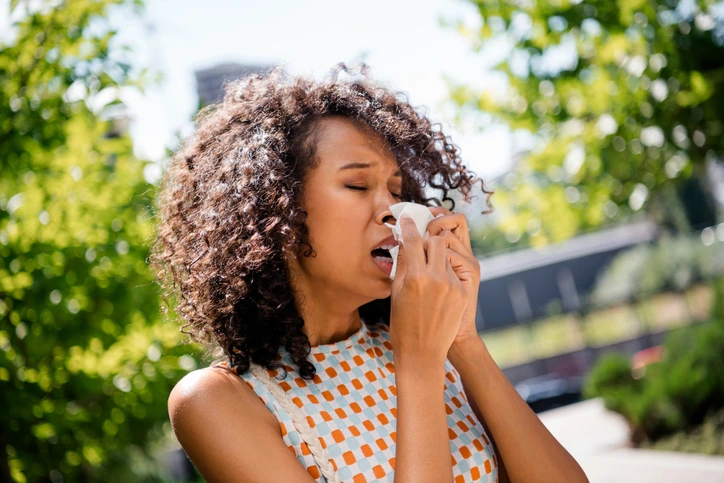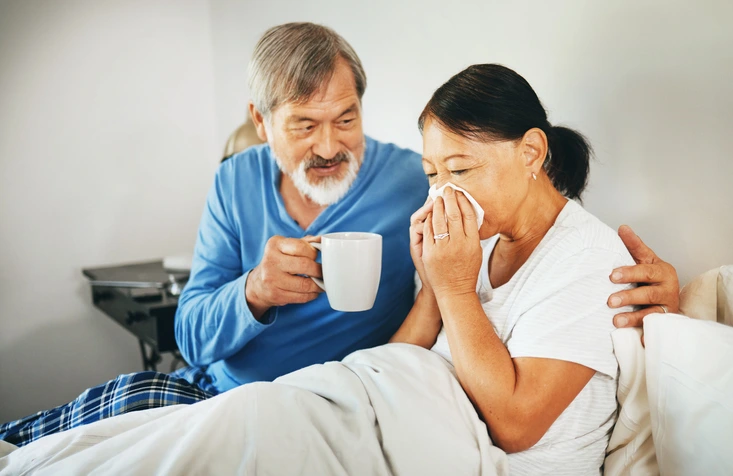As the weather warms up, most people get excited about the prospects of sunny days and summer vacations ahead. Getting a summer cold can ruin someone’s plans because not many people anticipate getting sick during the warmer months. The majority of people get sick when the weather is colder, not warmer, so some might wonder how it’s possible to even experience summer cold symptoms.

How Do You Get a Cold During Summer?
Cold symptoms experienced during the wintertime are usually caused by a virus known as a rhinovirus, which thrives in the cooler months and makes people more vulnerable to developing winter colds. Rhinoviruses pick up strength in the fall months and weaken as the weather warms up. There’s a different type of virus that causes the majority of summer colds, which is known as an enterovirus, which accounts for roughly 15 million illnesses a year between June and October. Enterovirus infections are the second most common cold virus, coming in right behind the rhinovirus.
Rhinoviruses spread more quickly in cold, dry weather, and in enclosed spaces, so they seem more contagious than enteroviruses. However, both viruses spread similarly. Both types of viral infections spread through small droplets in the air that are expelled from a cough, sneeze, or through talking. These droplets can also linger in public spaces, like swimming pools, which can lead to the development of summer cold symptoms.

How to Prevent Getting a Summer Cold
Spending time outside during summertime is a great way to get vitamin D and stay active, but maintaining good hand hygiene and blocking viral transmission when possible are the two best ways to prevent the onset of enterovirus infections. This means whenever you touch a shared surface, wash your hands thoroughly with soap and water, or use hand sanitizer if you don’t have access to a sink. Generally, washing your hands after being in a public space, such as an airplane or a public pool, is good practice. Other good habits to practice include avoiding touching your face, mouth, and nose as much as possible. Avoid sharing eating utensils and contact with people who are sick, and always disinfect surfaces you commonly share. Most people catch colds by touching a shared surface, such as a doorknob or a counter, then touching their face afterward.
You’re more susceptible to catching a cold if you spend a lot of time around children since small kids tend not to wash their hands regularly and spread germs through kissing and other forms of contact. If you spend time in enclosed public spaces, surrounded by other people in close contact, then you’re also more likely to develop cold symptoms during the summertime.
In the event you do get sick, make sure to cover your mouth and nose when you cough or sneeze to prevent the spread of the illness. Younger children, older people, and people with chronic illnesses are more vulnerable to common colds since their immune systems are weaker. These types of viruses can easily turn into more serious upper respiratory infections for people who don’t have a strong immune system to fight off infection.

Summer Cold Symptoms and How to Treat Them
The symptoms of a summer cold are similar to the symptoms you’d get with a winter cold. Scratchy throat, a runny nose, sore throat, a low-grade fever, congestion, lots of sneezing, and body aches are the most common symptoms of a cold you’d get from a rhinovirus or an enterovirus.
As you could’ve guessed, the treatment for a cold you’d get in summer is similar to how you’d treat a winter cold. Lots of rest, plenty of fluids, and over-the-counter medications, such as Tylenol, are great ways to ease your symptoms. A humidifier or a hot shower can help your congestion, but sleep is the best way to recover from a viral infection. Another way to help your body bounce back is by eating a diet packed with vitamin C to help your immune system regain its strength.
The symptoms of a summer cold typically go away within seven to ten days but do not hesitate to reach out to your healthcare provider if they last longer than that.
The Difference Between a Cold and Allergies
Seasonal allergies are common when the weather is changing and your body comes in contact with unfamiliar substances, such as pollen, different insects, mold, and grasses. They’ll make you sneeze, your eyes water, and you could feel fatigued.
The symptoms of a cold and allergies can overlap, but they’re very different from each other. While colds are infections of your upper respiratory system, allergies are immune system responses to allergen exposure. While a cold causes coughing, body aches, and sore throats, allergies do not. Allergy symptoms usually only consist of congestion and a scratchy throat, any more symptoms would point signs towards your allergies being a cold.
When in doubt, we advise you to seek care from a healthcare provider so your symptoms can be treated properly. Many symptoms from different infections and illnesses overlap, and the goal is always to prevent the spread. Whether it’s an enterovirus, rhinovirus, or even the coronavirus.

When to Seek Emergency Care if Necessary
Summer cold symptoms are easy to treat and don’t always require antibiotics, but some demographics are more vulnerable to the symptoms. These include people with chronic illnesses, young children, and elderly adults. If you or a loved one is experiencing trouble breathing, symptoms lasting longer than ten days, a fever that won’t break, worsening symptoms, or dehydration, we advise you to go to your nearest ER for help.
At Austin Emergency Center, we specialize in providing emergency care without the wait. Open 24/7 with concierge-level care, our team is here to help when you need it most.

